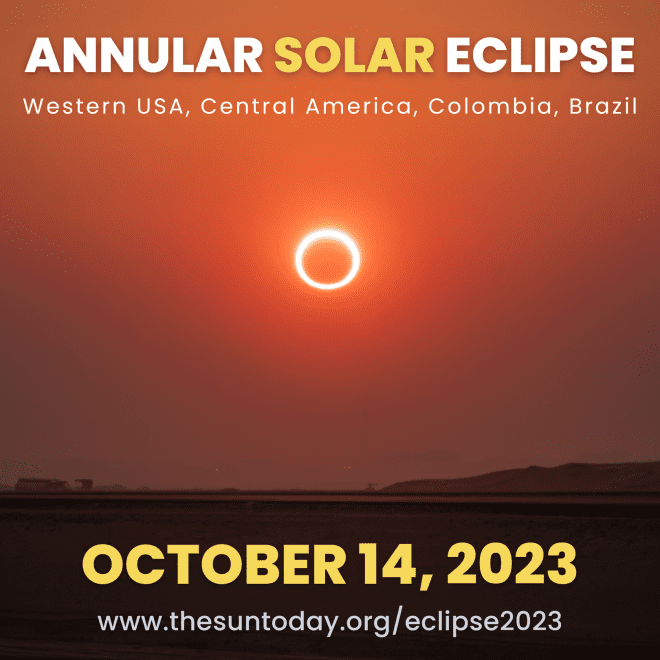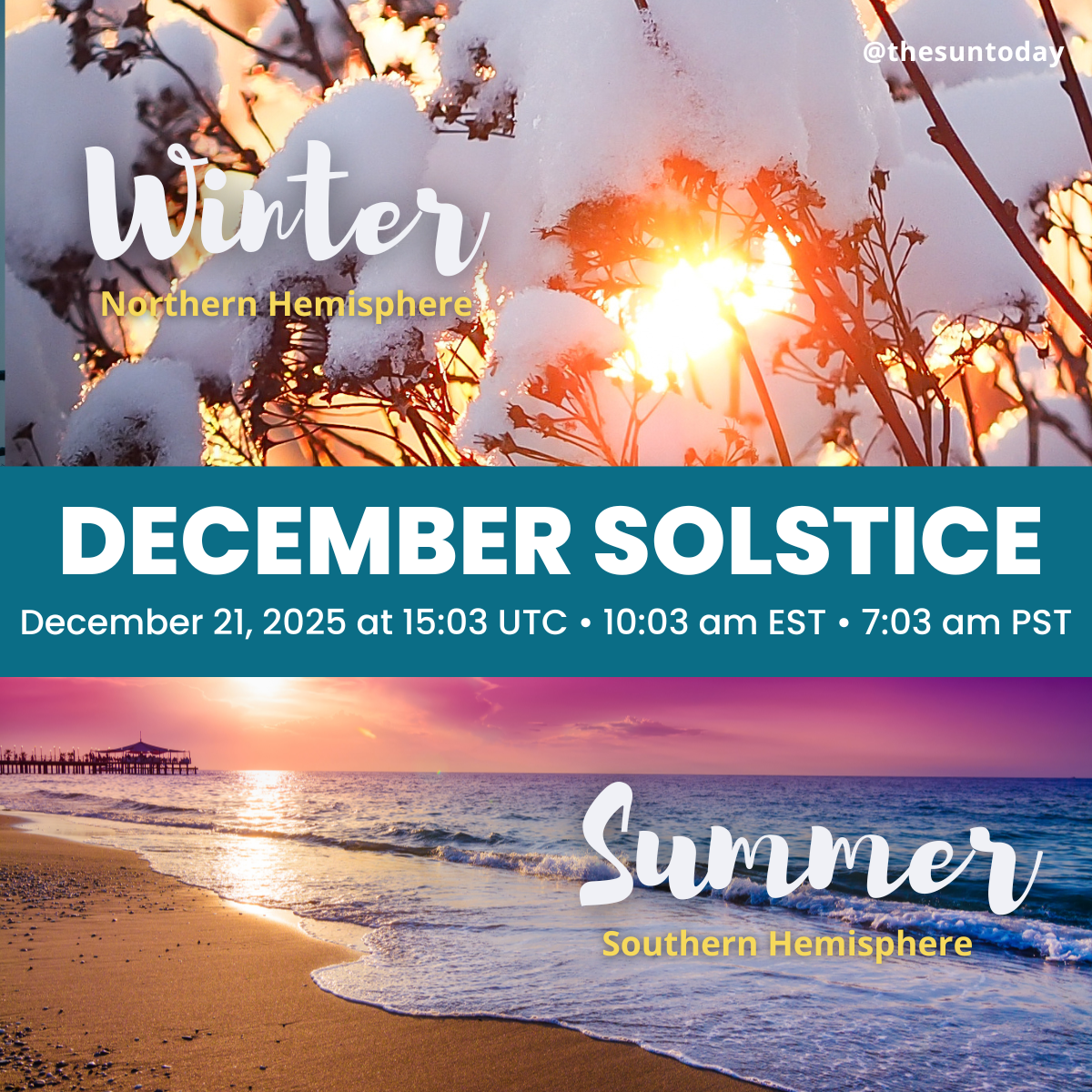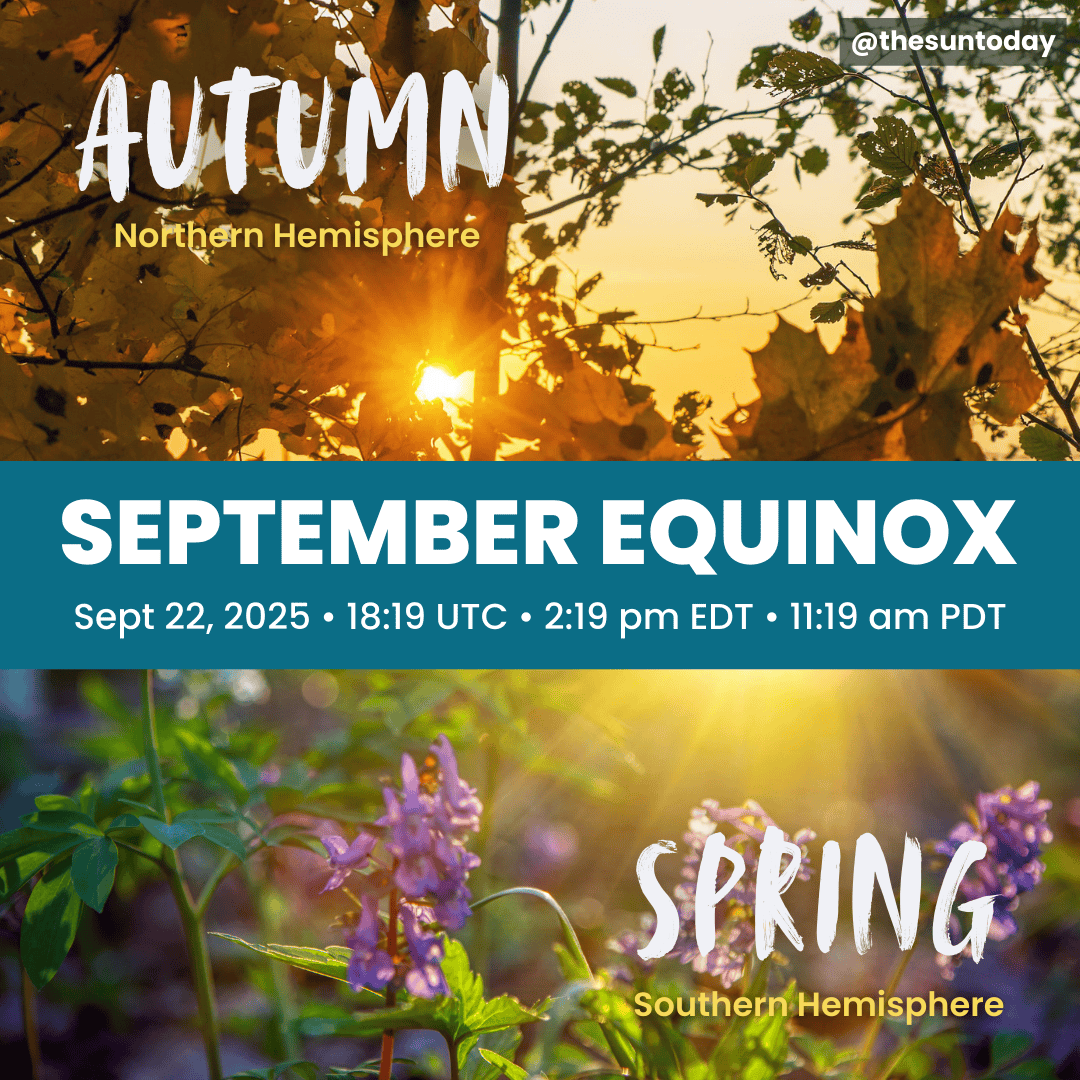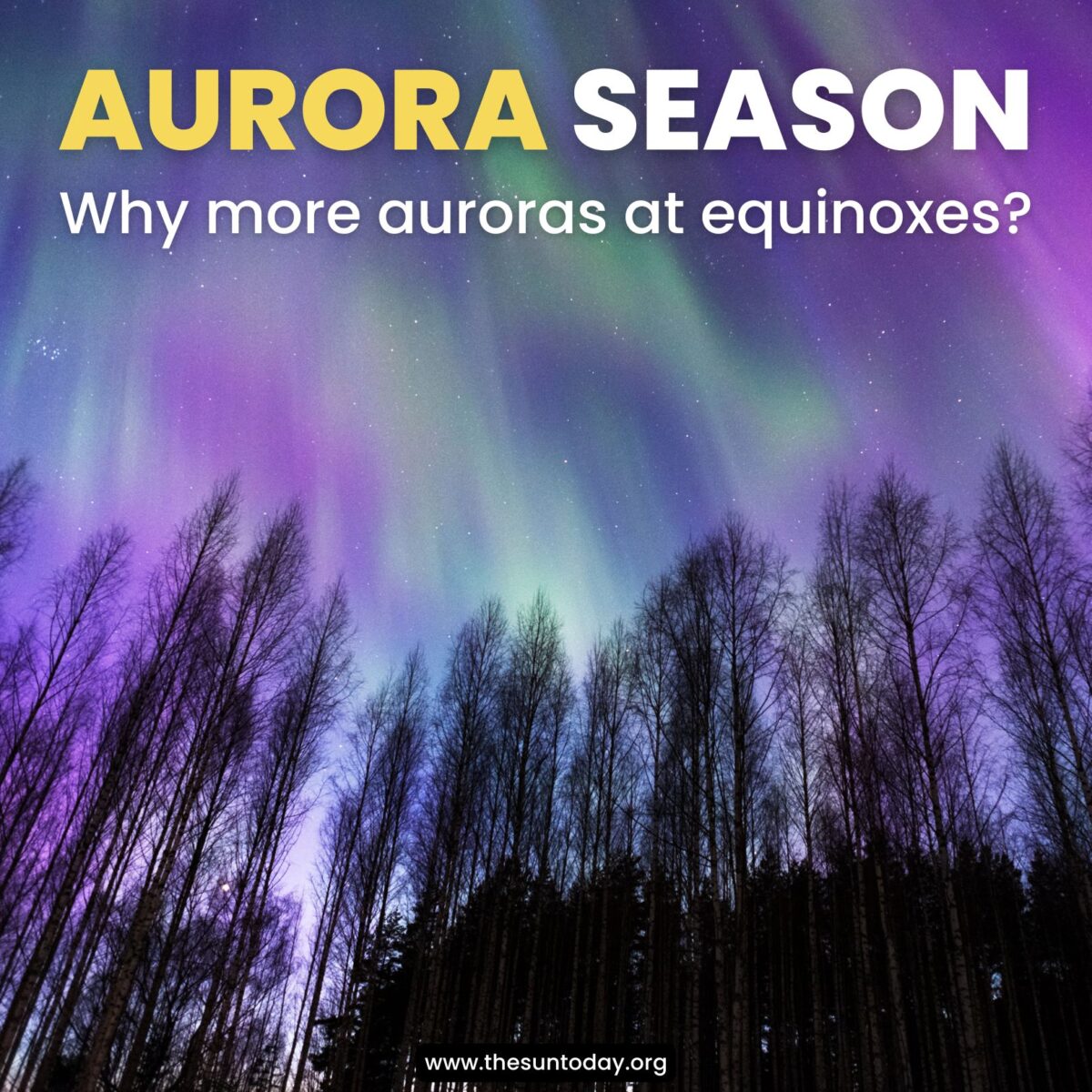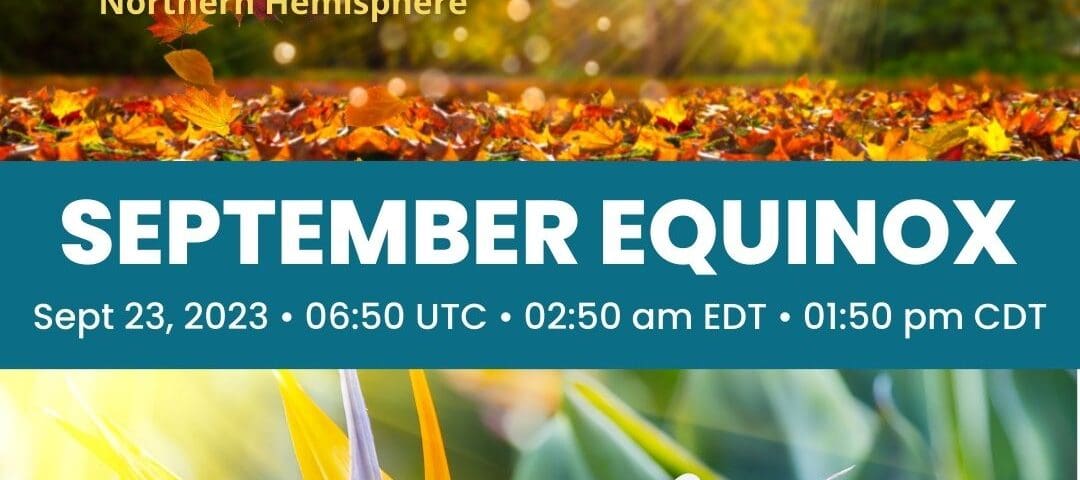
So many seasons thanks to the Sun!!
Get ready for Fall or Spring depending on where you live. It’s “nearly” equal amount of daylight and darkness at all latitudes.
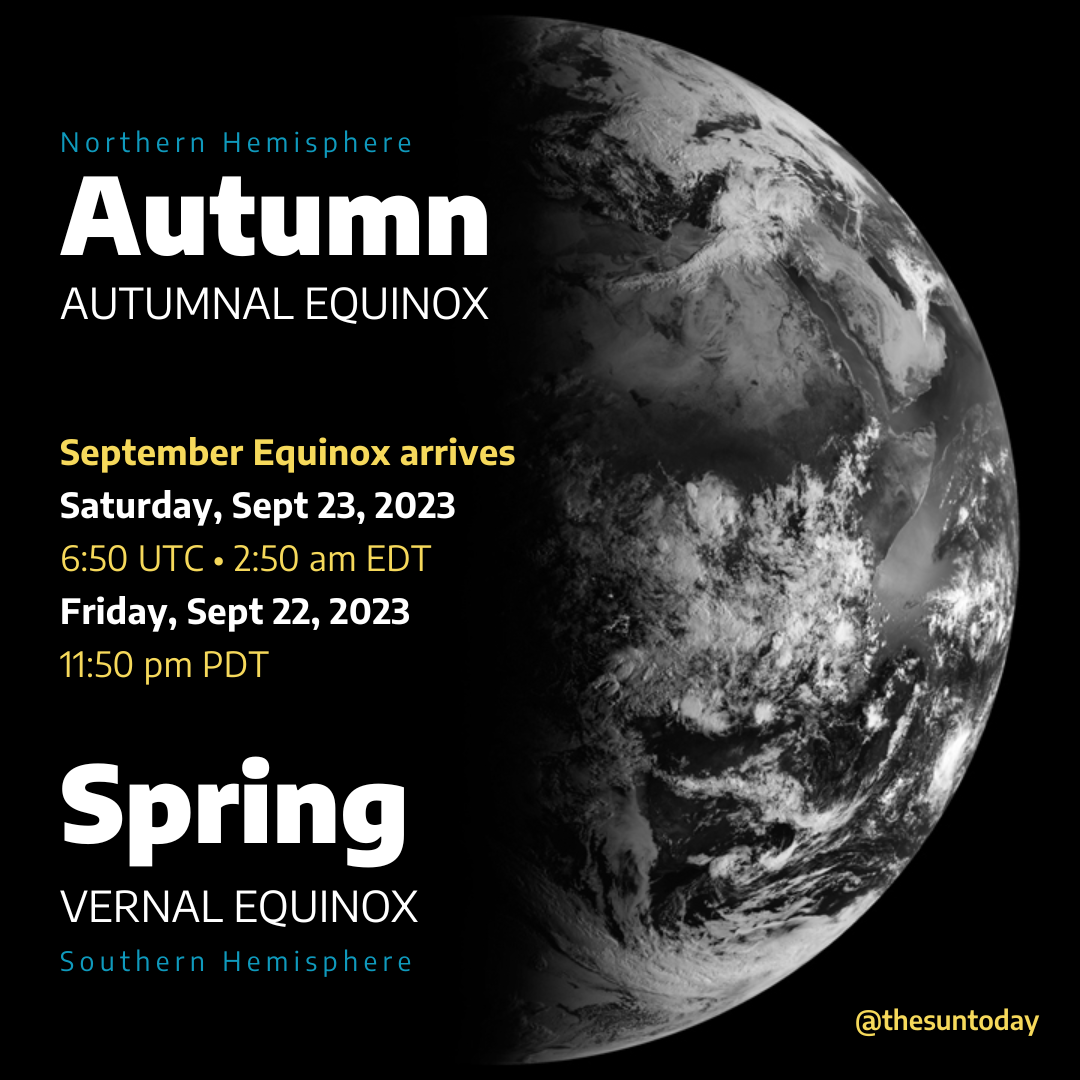
The Equinox occurs on Saturday, September 23, 2023 at 06:50 UTC (2:50 a.m. EDT • Friday, September 22, 2023 at 11:50 p.m. PDT).
Convert your timezone here!
- Equinoxes are the only two times a year when the Earth’s axis isn’t tilted toward or away from the sun.
- This means that at all latitudes, there is “nearly” the same amount of daytime and night.
- The word “equinox” comes from two Latin words: aequus (meaning “equal”) and nox (meaning “night”).
- At the equator, the sun is directly above at noon on these two equinoxes.
- The “nearly” equal hours of day and night are caused by the sun’s rays being bent, which makes it look like the sun is above the horizon even though it is actually below it.
- Higher latitudes, which are farther from the equator, also have slightly longer days because it takes the sun longer to rise and set.
So, on the equinox and for a few days before and after, the length of the day will vary from:
- 12 hours and 6 1/2 minutes at the equator to
- 12 hours and 8 minutes at 30 degrees latitude to
- 12 hours and 16 minutes at 60 degrees latitude.
It’s the Autumnal (Fall) equinox for the Northern Hemisphere!

It’s the Vernal (Spring) equinox for the Southern Hemisphere!

“Here comes the sun, doo-doo-doo-dooHere comes the sun, and I sayIt’s alright”
Equinoxes like solstices are not only a time to celebrate changing seasons, but they are also a time to celebrate the object at the center of it all, the Sun! So before we jump into the nitty gritty about equinoxes, it is a good time to go over what is happening related to the Sun this year and next year. There is a lot of sun related events coming soon to the star near you.
- Not long after the equinox the NASA spacecraft, Parker Solar Probe, makes its next close approach to the Sun on the way to its closest approach December 24, 2024. This close approach to the to the Sun is called perihelion. This next one is number 17 happening on September 27, 2023. Its closest perihelion in December 2024 is number 24.
- Next much of North and South America, will experience an annular solar eclipse on October 14, 2023. Find out more here.
- We will have another solstice in December 2023 and an equinox in March 2024.
- One of the main sun events is the total solar eclipse on April 8, 2024 that starts in Mexico, crosses the US from Texas to Maine, ending in northeastern Canada. This event will be similar to the eclipse of August 21, 2017 but the path is wider and the durations of totality are longer.
- All of this excitement happens while the Sun continues to approach solar maximum, its peak of activity during its 11-year solar activity cycle. This should happen sometime in mid-to-late 2024 to mid-2025.
Truly a great time for fun with the Sun!
“It’s those changes in latitudes, changes in attitudes…Nothing remains quite the same”
The astronomical event, known as an equinox, occurs twice each year, the March equinox (around March 20) and the September equinox (around September 22), when the plane of Earth’s equator passes through the center of the sun.
On the June solstice, the sun reaches its highest point in the sky for an observer at the North Pole. On the December solstice, the sun reaches its highest point in the sky for an observer at the South Pole. Solstices mark the change from fall to winter or spring to summer.
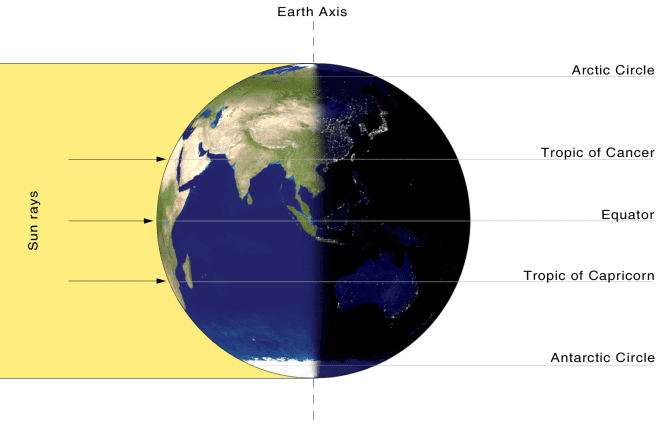
During an equinox, the Earth’s North and South poles are not tilted toward or away from the Sun, and the duration of daylight is theoretically the same at all points on Earth’s surface. Image via National Geographic
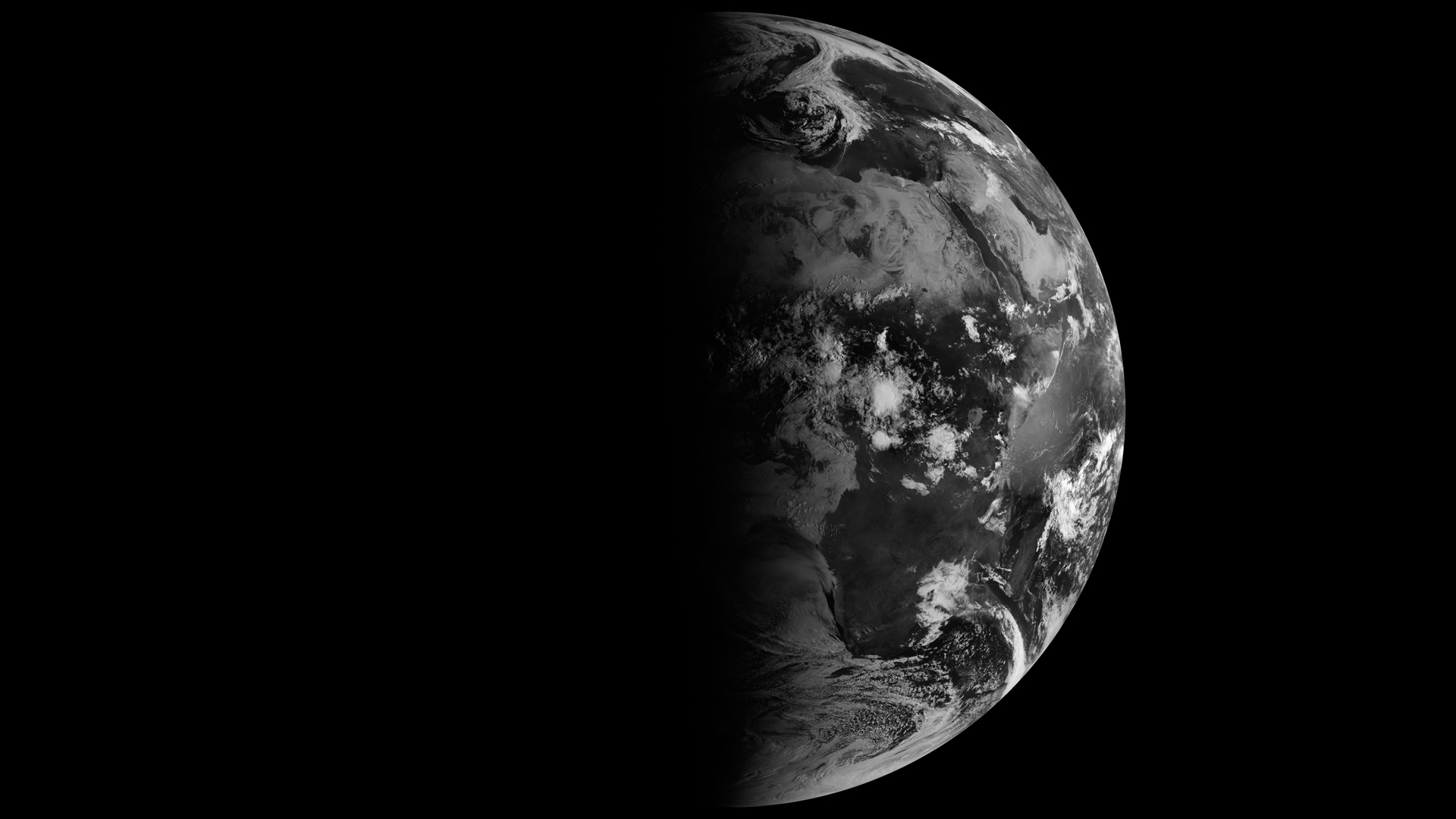
On the September equinox, the terminator is a north-south line, and the sun is said to sit directly above the equator. CREDIT: NASA’s Earth Observatory
Credit: National Geographic
Not Entirely Equal Day & Night
On an equinox, the Sun shines directly on the equator and the length of day and night is nearly equal – but not quite. They are not exactly equal because of the angular size of the sun and atmospheric refraction. The word equilux is used to mean a day in which the durations of light and darkness are equal to distinguish the day from an equinox.
The March equinox marks the moment the Sun crosses the celestial equator – the imaginary line in the sky above the Earth’s equator – from south to north and vice versa in September. The equinoxes are the only times when the solar terminator (the dividing line between night and day) is perpendicular to the equator. Then the northern and southern hemispheres are equally illuminated.
Equinoxes are the only times when the subsolar point is on the equator, i.e. the Sun is exactly overhead at a point on the equatorial line. The subsolar point crosses the equator moving northward at the March equinox and southward at the September equinox.
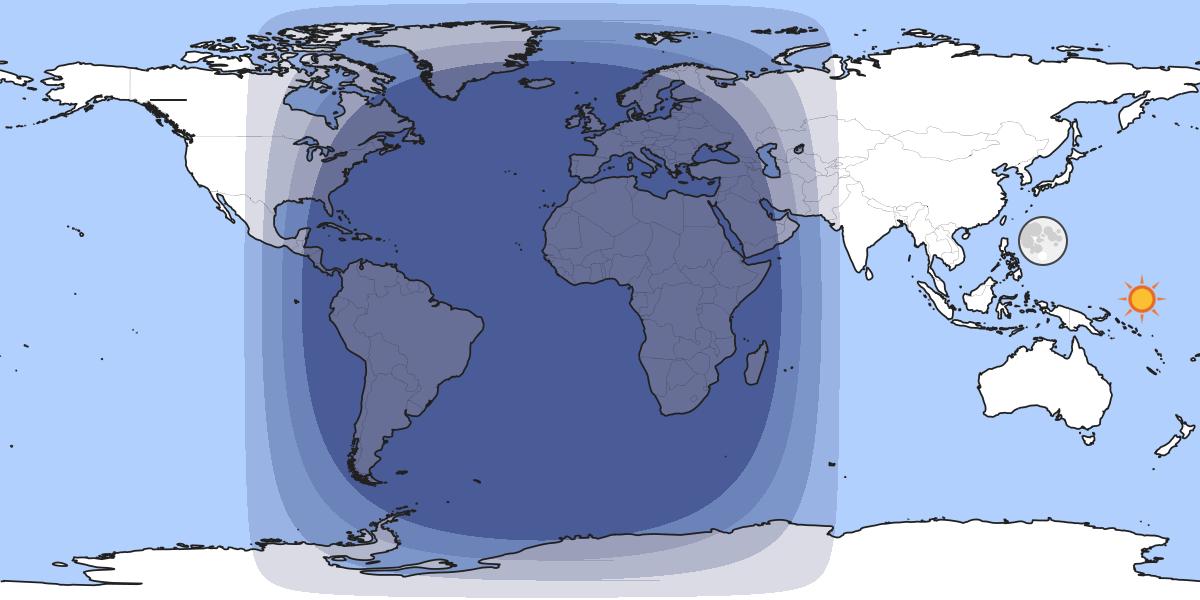
This map shows the position of the Sun and the Moon during the September 23, 2022 equinox at 1:03 UTC (Thursday, September 22, 2022 at 9:03 p.m. EDT • 6:03 p.m. PDT ). It shows which parts of the Earth are in daylight and which are in night. CREDIT: www.timeanddate.com
![]() = The Sun’s position directly overhead (zenith) in relation to an observer.
= The Sun’s position directly overhead (zenith) in relation to an observer.
![]() = The Moon’s position at its zenith in relation to an observer (Moon phase is not shown).
= The Moon’s position at its zenith in relation to an observer (Moon phase is not shown).
Civil Twilight (lightest shade)
Nautical Twilight (next darker shade)
Astronomical Twilight (next darker shade)
Night, no twilight (darkest shade)
The equinoxes and solstices are directly related to the seasons of the year. In the northern hemisphere, the vernal equinox (March) conventionally marks the beginning of spring while the autumnal equinox (September) marks the beginning of autumn. In the southern hemisphere, the vernal equinox occurs in September and the autumnal equinox in March.
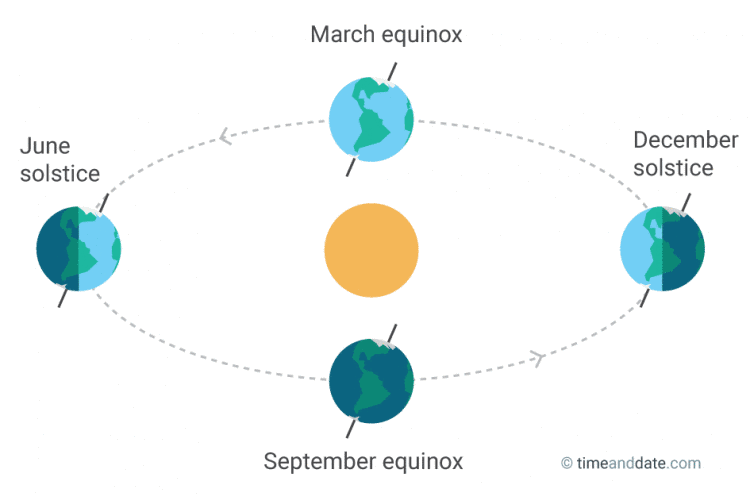 CREDIT: www.timeanddate.com
CREDIT: www.timeanddate.com
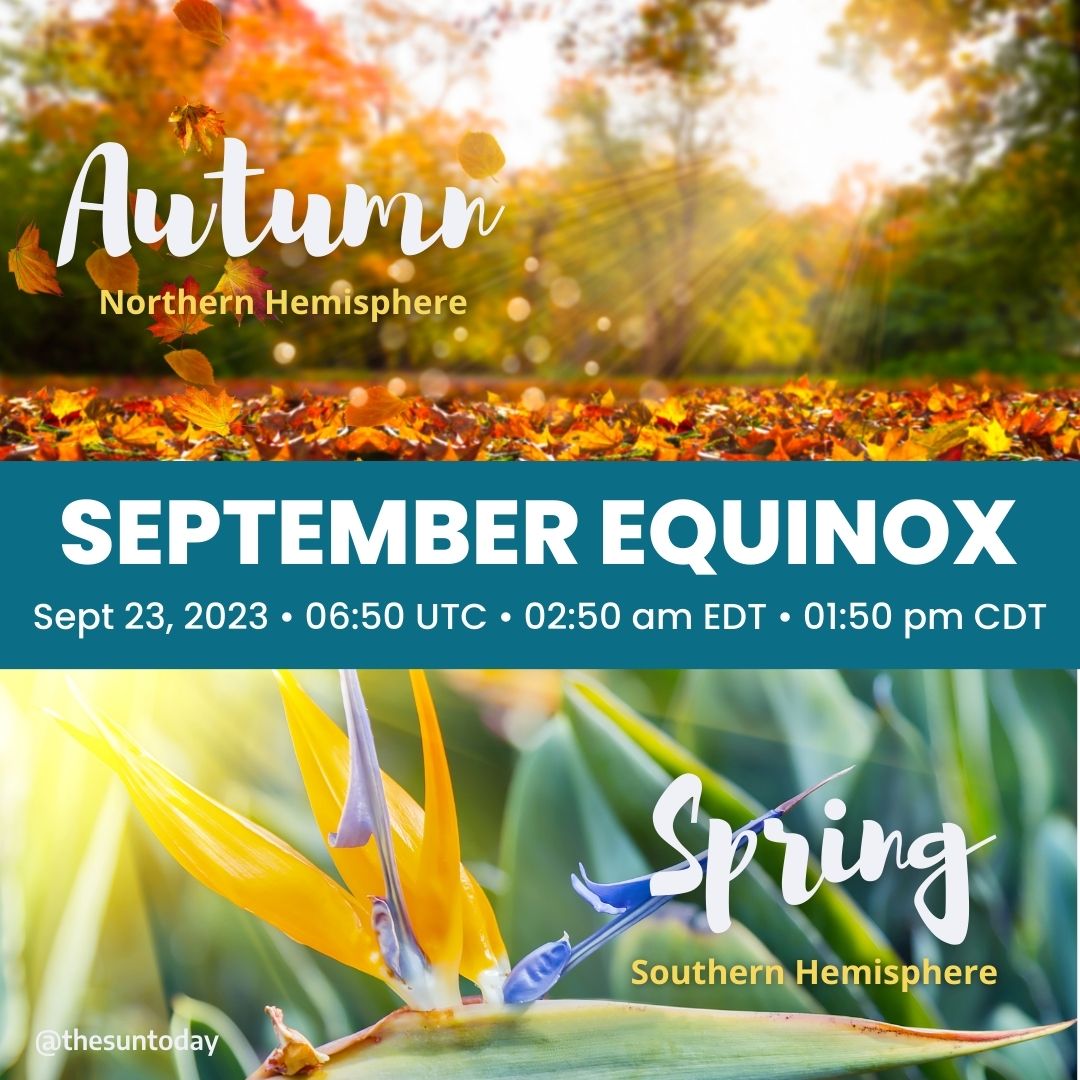
Seeing Equinoxes and Solstices from Space
CREDIT: NASA Meteosat (Archive from 2011)
“One of the most frequently misunderstood concepts in science is the reason for Earth’s seasons. As we experience the September equinox today—anyone try to balance an egg yet?—we thought we’d offer a space-based view of what’s going on.
Around 6 a.m. local time each day, the Sun, Earth, and any geosynchronous satellite form a right angle, affording a nadir (straight down) view of the terminator, the edge between the shadows of nightfall and the sunlight of dusk and dawn. The shape of this line between night and day varies with the seasons, which means different lengths of days and differing amounts of warming sunshine. (The line is actually a curve because the Earth is round, but satellite images only show it in two-dimensions.)
The Spinning Enhanced Visible and Infrared Imager (SEVIRI) on EUMETSAT’s Meteosat-9 captured these four views of Earth from geosynchronous orbit. The images show how sunlight fell on the Earth on December 21, 2010 (upper left), and March 20 (upper right), June 21 (lower left), and September 20, 2011 (lower right). Each image was taken at 6:12 a.m. local time.
On March 20 and September 20, the terminator is a straight north-south line, and the Sun is said to sit directly above the equator. On December 21, the Sun resides directly over the Tropic of Capricorn when viewed from the ground, and sunlight spreads over more of the Southern Hemisphere. On June 21, the Sun sits above the Tropic of Cancer, spreading more sunlight in the north and turning the tables on the south. The bulge of our spherical Earth blocks sunlight from the far hemisphere at the solstices; that same curvature allows the Sun’s rays to spread over more area near the top and bottom of the globe.”
We can even see how the sun illuminates Earth during an equinox thanks to a NOAA satellite.
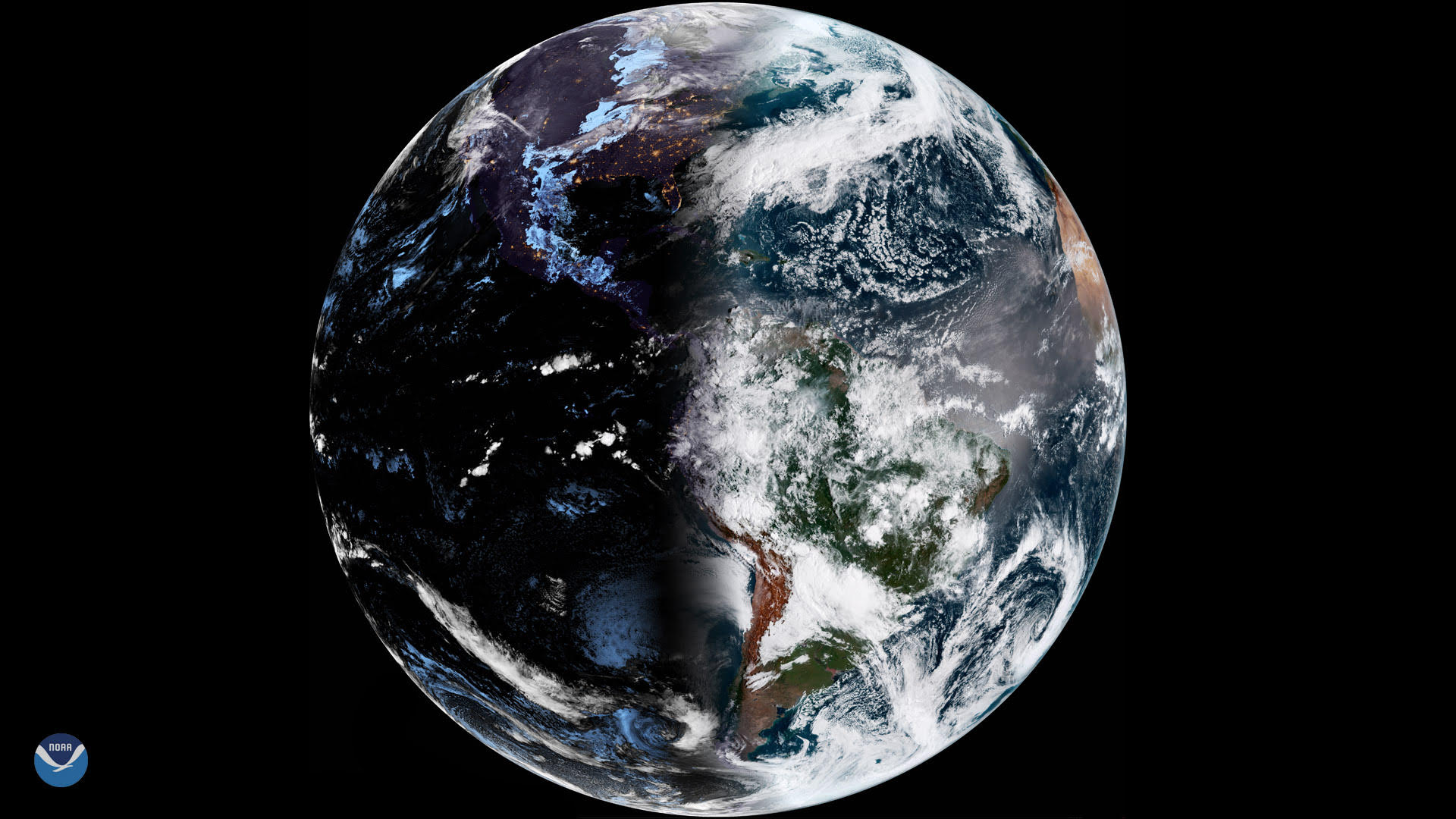
GOES East captured view of the March 20, 2019 equinox. CREDIT: NOAA/GOES
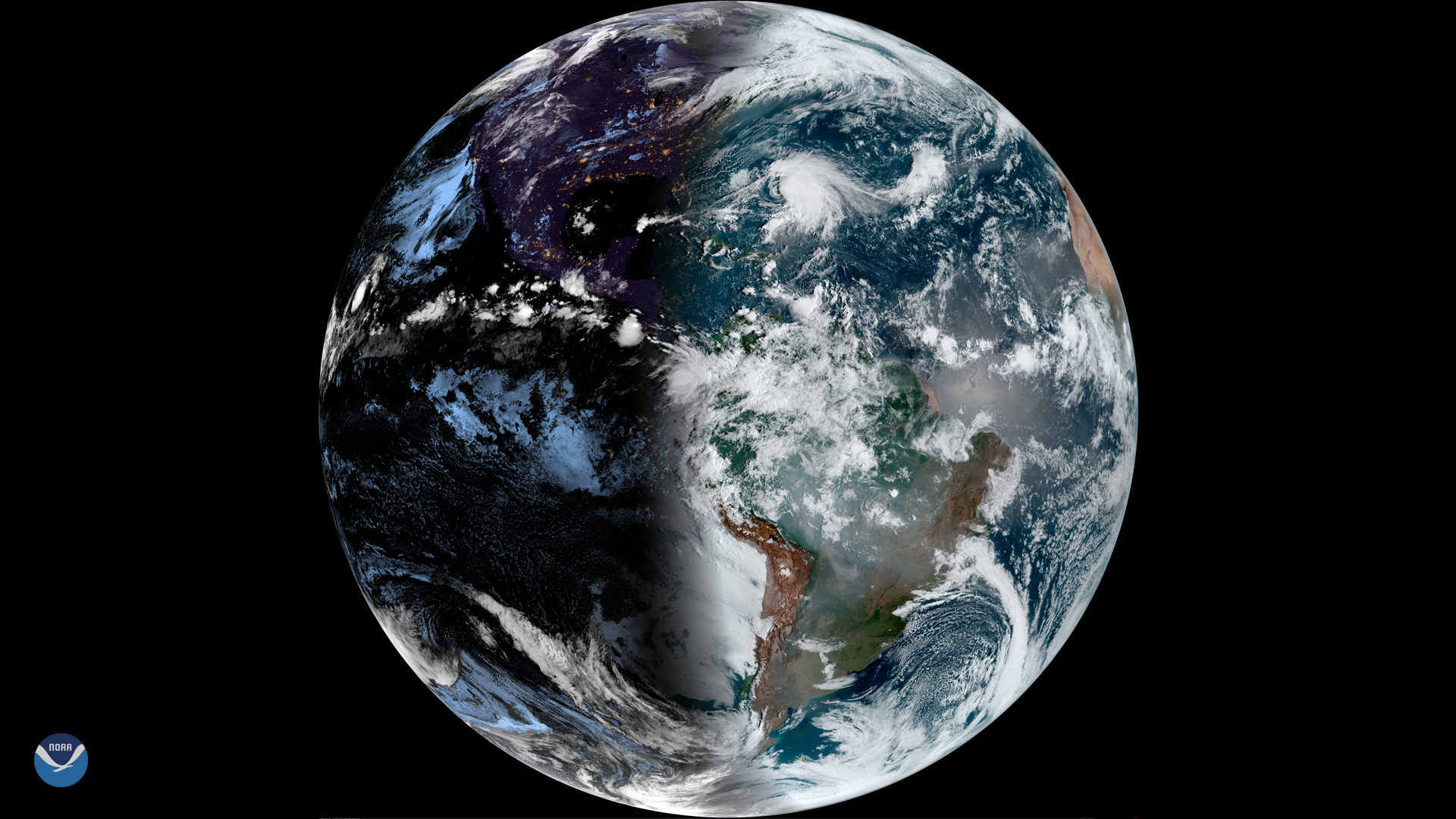
This NOAA GOES East image was captured on Sept 23, 2019, at 8:00 a.m. EDT – The September 2019 Equinox. CREDIT: NOAA/GOES East
Change of Seasons
Earth’s tilted axis causes the seasons. Throughout the year, different parts of Earth receive the Sun’s most direct rays. So, when the North Pole tilts toward the Sun, it’s summer in the Northern Hemisphere. And when the South Pole tilts toward the Sun, it’s winter in the Northern Hemisphere.
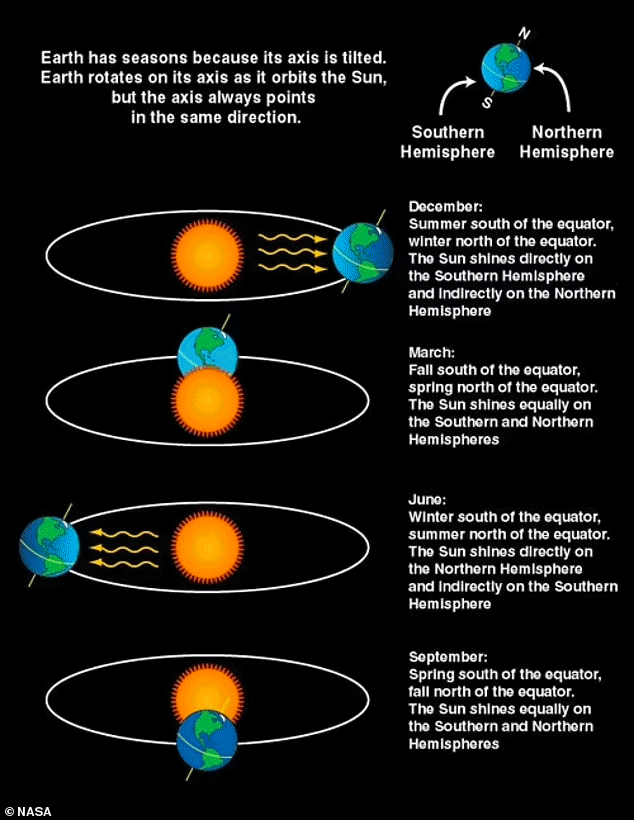
Learn more about the change of seasons
It’s also time for Aurora Season!!
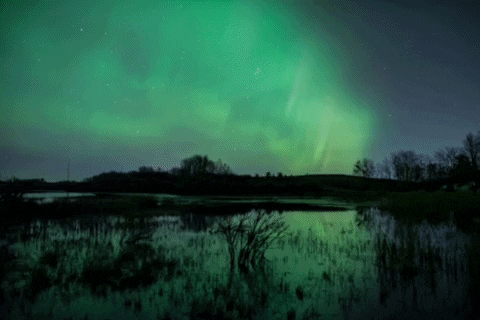
Aurora season is winding down in the higher southern latitudes, but there is still time to witness it in person. It varies slightly by location. The Northern Lights season is just getting started. It is from September until March. This is because the aurora can more easily be seen due to longer nights.
Studies have shown that during both the fall and spring equinoxes geomagnetic disturbance and thus aurora are twice as likely as during summer and winter.
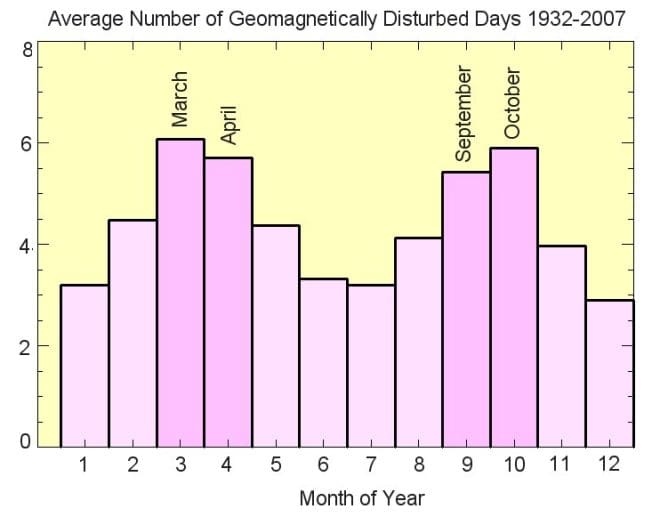
This figure by solar physicist David Hathaway of NASA Marshall Space Flight Center uses 75 years of data to show the relationship between the number of geomagnetic disturbances and the time of the year.
For a long time, scientists did not know what made equinoxes special. Using data from space missions such as THEMIS, scientists now know that it is all about geometry. THEMIS showed us that there are special magnetic ropes connecting Earth’s upper atmosphere directly to the sun. During the spring and fall equinox, the geometry of the Earth with respect to the sun is such that its magnetic field is best oriented to connect with the sun. Learn more about aurora season and equinoxes at EarthSky.
Solar activity is increasing in this current solar cycle, so hopefully, there will be more aurora.
We can all look for great photos and videos shared online, even if we can’t be there in person. It’s still a bucket list item for us to see this in real life!
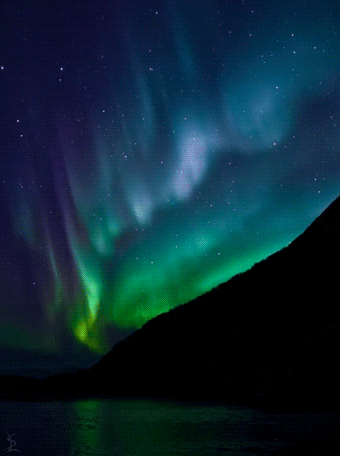
Earth is not the only place in the solar system that experiences seasons!
Other planets also have seasons. You can learn more about planetary seasons from NASA. The same is true for aurora. They also don’t just happen on Earth. Several different planets have aurora but some of the strongest and most spectacular outside of Earth are on the planet Jupiter. Two of NASA’s great space telescopes have observed Jovian aurora, Hubble and Webb. Whether or not other planets also have aurora seasons is a great question. Something for scientists to research further.
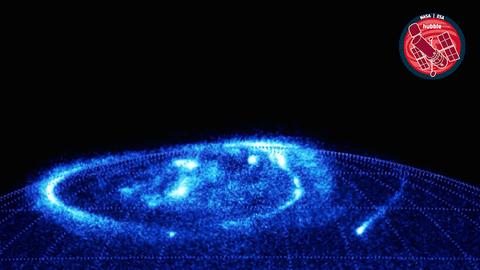
The Hubble is one of NASA’s great space telescopes. It captured images of Jupiter’s massive aurora with ultraviolet light. This is from the Hubble partner’s at the European Space Agency or ESA. Image via ESA.
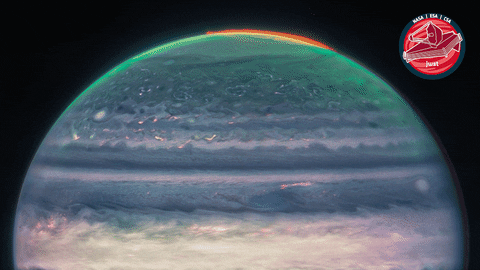
JWST, commonly known as Webb, is one of NASA’s great space telescopes. It captured images of Jupiter’s massive aurora with infrared light. This is from the Webb partner’s at the European Space Agency or ESA. Image via ESA.
Last but not least, it’s eclipse season!
Did you know there is an annular solar eclipse coming up on October 14, 2023?! And you must have eye protection to view it in person.
Many people will be in the eclipse path, but you must have eye protection to safely look at it. Or view it online. We have all of the details here!
[ycd_countdown id=16576]
Find out the annular eclipse details here…
There will also be a small Partial Lunar Eclipse on October 28–29, 2023. It’s eclipse “season” when the earth can view two or three eclipses in a short time frame. Every new moon (solar eclipse) will be followed by a lunar eclipse (full moon). Sometimes the orbits line up to produce another eclipse. The next eclipse season will be next spring, with the last big total solar eclipse in the USA until 2045. This is a huge deal, so learn more about the total solar eclipse on April 8, 2024, and start making your travel plans now.
‘Tis the SeaSon! Stay tuned for more sun fun…

And be like Jimmy & make the most of your trips around the sun!
Jimmy Buffett & Martina McBride – License to Chill ℗ 2004 Mailboat Records Inc. Released on: 2004-07-13 Composer, Writer: Alan G Anderson Composer, Writer: Sharon M Vaughn Composer, Writer: Stephen Bruton
CREDITS: NASA, NOAA, spaceweather.com, Wikipedia, EarthSky.org, The Beatles, Jimmy Buffett


